Kettlebells and Bodyweight Exercise: The Ultimate Training Duo
By Phil Ross, Master RKC
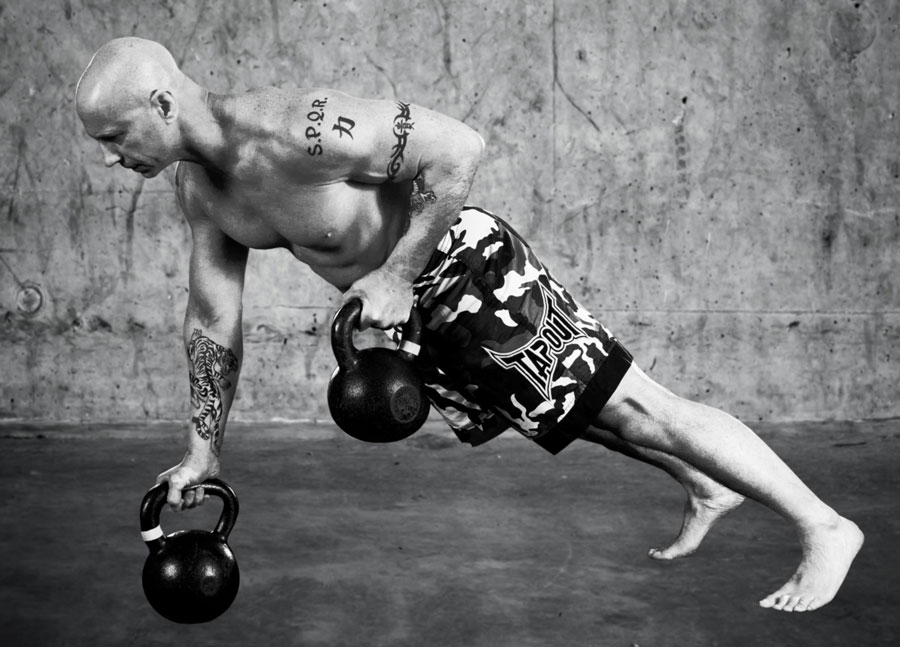
There are many purported methods for achieving the ultimate level of fitness. Some are better than others. But, is there one tool, method, or philosophy that shines above them all? Fitness has five aspects: muscular strength, muscular endurance, cardiovascular fitness, flexibility and body composition. To achieve an optimal level of fitness, each area must be addressed.
With a ridiculously large variety of strength and conditioning systems— kinetically based, explosive power, P90X, Orange Theory, Powerlifting, Olympic lifting, bodybuilding, CrossFit, fitness boot camps, speed initiatives, sport specific, and age specific to name a few—how does a fitness enthusiast or athlete choose the right one? First, determine the eventual goal(s). If one desires to become a bodybuilder, do so, a powerlifter, go hard and heavy. But if someone wants to achieve incredible fitness with one tool or method, pick up a kettlebell, then add calisthenics and skipping rope. Most fitness programs require gyms with rows of machines, racks of dumbbells and a slew of cardio machines—or attending the latest group workout fad classes with blaring music and a screaming spandex-clad instructor.
...Or you could learn how to use a
kettlebell. One of the distinct advantages of a kettlebell and bodyweight training system is the small amount of equipment required. To achieve lifelong, ultimate fitness all that is needed is a jump rope, staff (dowel), a pull-up bar and four pairs of kettlebells (Ross & Gallagher, 2016).
The Three Categories of Kettlebell Movements
Kettlebell movements are categorized as ballistics, grinds and mobility-enhancing movements. Ballistic movements include the
kettlebell swing, clean, and snatch. They develop hip drive, explosive power and muscular and cardiovascular endurance. The grinds include the kettlebell press, squat, deadlift, row, and floor press. Grinds increase raw power and strength. Mobility-enhancing exercises like the
get-up, the armbar and the kettlebell pullover enable the practitioner to learn how to pack their shoulders and move fluidly throughout the thoracic and lumbar regions as well as the hips. There are also a few hybrids and balance-enhancing movements such as loaded carries, kettlebell thrusters, single leg deadlifts and the push press which address two or more categories simultaneously.
Kettlebells and the Three Planes of Human Movement
There are three planes of human movement: frontal, sagittal and transverse. The frontal plane is observed by viewing a body from the front and/or back and consists of lateral movements. Postural assessments may be garnered from this view and well as the sagittal plane which includes movements that are viewed from the side (Green, 2014). The movements and training involved in most modes of resistance training, free weights, machines, and dumbbells reside only in the sagittal and frontal planes. Most sports—and life in general—occur in the transverse plane.
According to Dr. Ben Fung:
"Kettlebells have a distinct advantage to other modalities of exercise in that they are physically and naturally ergonomic. As every earthbound human body is victim to gravity, every free body object manipulated by the human body physically acts like a kettlebell. In terms of physics, a kettlebell essentially is a handle with a big heavy weight attached at the bottom of the handle. There are infinite examples of how this is expressed in our daily lives: suitcases, bags, backpacks, shopping carts, door handles, buckets, chairs… the list goes on. Due to gravity, no matter how one lifts a free body object, the point of grip/contact becomes the handle and the remaining mass becomes the big heavy weight at the bottom" (Fung & Shore, 2010).
When an exerciser uses machines, the mechanisms guide them through an exercise while maintaining strict adherence to movement
only in the frontal or sagittal planes. Yes, muscles are being worked, but the stabilizers are not taxed or strengthened. And, what about the
intrinsic muscles? Where is the impetus for the body to recruit them to accomplish the movement?
Standards of Strength
When pondering the standard for strength—the bench press—the first words out of a gym rat’s mouth are, "How much do you bench?" Is this movement the ultimate indication of strength? I think not—and I’m not alone. Recently, the Indianapolis Colts abandoned their bench press test in favor of using the famed kettlebell Turkish get-up. The get-up has become their new barometer for determining overall strength, the ability to move, adjust body position, and flexibility (Holder, 2016).
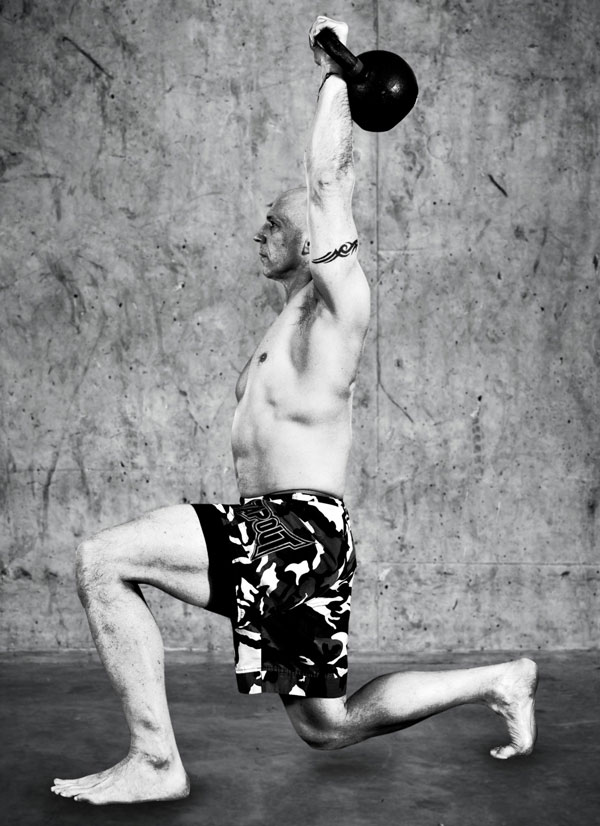
The Colts aren’t the only professional team to move toward kettlebell training. The newly appointed Head Strength Coach for the New York Football Giants, Aaron Wellman, took a
one-day kettlebell certification, the HKC (Hardstyle Kettlebell Certification) course with me. The Tennessee Titans, Boston Celtics, Atlanta Falcons, NY Yankees also use kettlebell training as a staple for their strength and conditioning. These teams are just a few of the many professional sports teams leveraging the benefits of
kettlebell training.
The list of combat athletes and NCCA Division 1 wrestling teams using kettlebell and bodyweight training is far too large to list. Even the U.S. military employs this type of training for the most elite members of our special forces.
The Origins of the Most Popular Weight Training Methods
The standard, classic measures of strength come from the three lifts of powerlifting: bench press, deadlift and back squat. Are these great indicators of 1RM (one repetition maximum) of strength? The answer is yes. But this does not necessarily translate to sports performance.
At some point, excess muscle bulk and a lack of flexibility that can result from this training method will actually impede sports performance and increase the risk of injury. Additionally, the tendency to neglect form—or abandon proper technique—for the sake of moving a heavier weight exposes the exerciser to additional injury. The goal of powerlifting is to achieve heavy lifts in the sagittal planes in the bench, back squat and deadlift, it is not muscular endurance, symmetry or balance. The powerlifting movements are all grinds.
Olympic lifting is another standard with the clean and jerk as well the snatch. Both of these exercises are incredible for developing explosive power, but there is a high level of athleticism required to perform these movements safely and effectively. Many people will never be able to do them (Takano, 2015). These ballistic movements are also extremely risky and can wreak havoc on an athlete’s wrists.
Bodybuilding is another method of acquiring strength. However, the main goal of bodybuilding is to create a large and symmetrical build. This approach often employs muscle isolation and open chain movements. Training in this way can lead to muscular overdevelopment and reduced speed and explosive power. Additionally, when we move in our daily lives or compete in athletics, we never isolate our muscles. Athletes can and do gain strength from these other methods, but they are not nearly the safest, most beneficial, or efficient way.
The Origins of Kettlebell Training
There is evidence that
kettlebell training dates back as far as Ancient Greece. But, the Russians made this training method popular and have used it ever since the 1800s. A famed strength coach, Vladislav Kraevsky (the father of Russian Olympic lifting), traveled the Russian countryside and discovered that the workers at the scales possessed incredible strength. Farmers would bring their produce to the scales and the workers would throw kettlebells of various weights onto the scales to determine the weight of the produce. After roughly a decade training and developing a training regimen, Kraevsky opened a facility with kettlebells and barbells. By the 1900s Russian weightlifters and soldiers were using kettlebells as part of their strength and conditioning program (Ngeyun, 2016). The hip hinge and shoulder stabilization were incredibly useful for the athletes and soldiers.
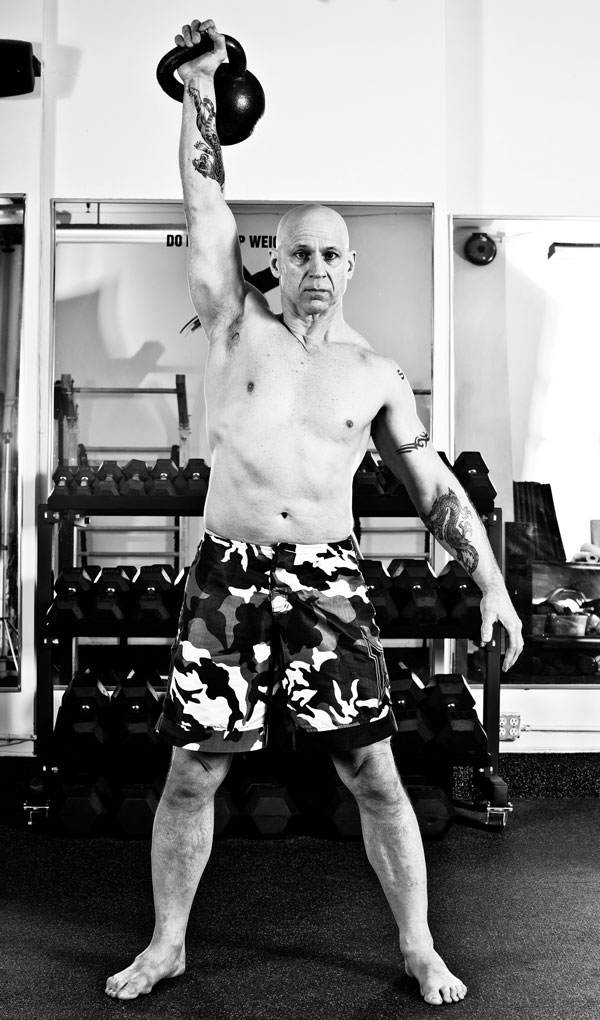
Choosing the Right Tool
An athlete (or exerciser) needs to determine their ultimate goal—and the right tool for the job. If size and lifting heavy weights for one rep maximums are the goal, barbells are the answer. If someone desires a high level of overall fitness and strength with the ability to incorporate ballistics safely, then kettlebells are the answer.
Kettlebell training is less taxing on the wrists, especially for power cleans, front squats, and snatches (Read, 2013). Using a barbell for these same movements places the wrists at risk of injury (Tanko, 2015). A barbell fixes the hands in one spot, while kettlebells permit free movement of the shoulders and arms—enabling the wrist to stay straight and strong for all the kettlebell movements including cleans, snatches and front squats.
Dan John and Jason Brown offered their opinions in Men’s Health magazine:
"There is no better tool for adding load than the barbell," says Dan John, a national masters champion in Olympic lifting and a strength coach in Draper, Utah. For those strength-building exercises that can require substantial weight—such as the bench press, dead lifts, squats, or snatches—John says only the barbell can meet the resistance needs of some lifters. Jason Brown added: "If your goal was just to get strong, you don’t need kettlebells," Brown says. "If your goal is to burn fat, increase power endurance, and get strong, then kettlebells are a great tool" (Heid, 2012).
If your sport, goal, or activity requires you to substantially increase your overall size, you’ll need to use
heavy barbells. This is not to say that you won’t put on muscle with kettlebell training, but barbells are a better tool for achieving that goal.
Conditioning
In the realm of overall body and cardiovascular conditioning, a workout must include all of the energy systems to be considered effective. The three main energy systems, the phosphagen, anaerobic glycosis (lactic acid) and aerobic systems need to be accessed (Bryant, 2012). As the chart below indicates, various combinations of the specific systems occur during an exercise session, or a competition lasting more than 30 minutes. Note that the heart doesn’t really know if the body is running, cycling or swinging a kettlebell for 30 minutes, as long as the increased demand for oxygen is required. The heart will work harder to meet these needs, aerobic conditioning will improve, and fat stores will be utilized.
In comparison to simply running, a high intensity
kettlebell workout will also create muscular endurance and strength—as well as improve body composition, and flexibility through the range of motion of the movements. As noted by the American Council on Exercise, "Kettlebells require an individual to focus on whole-body conditioning because lifting and controlling a kettlebell forces the entire body, particularly the core, to contract as a group, simultaneously developing strength and stability." The kettlebell’s ability to work multiple muscle groups at once means that this training improves endurance as well as strength (Green, 2014).
Kettlebell training has other advantages over traditional resistance training for strength and the typical cardiovascular training: mobility and athletic development.
The five areas of fitness are met by kettlebell and
bodyweight training alone, and additional components for athletic performance are met as well.
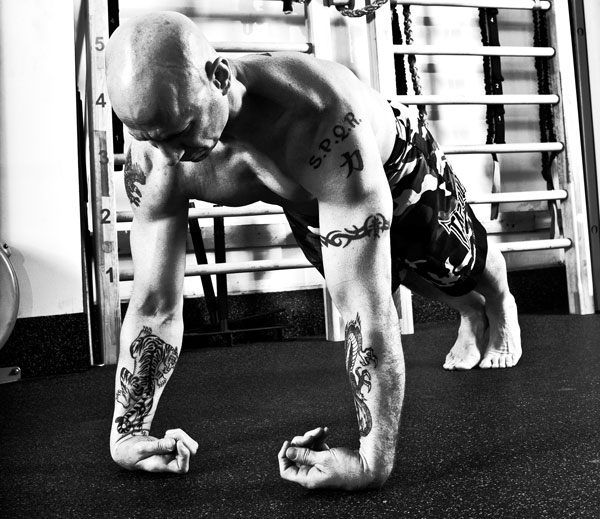
The ability to perform repeated
explosive power movements in a relatively safe fashion while training the hip hinge motion are touted advantages of kettlebell training. The hip hinge is used in the ballistic movements, the lower body grinds, and the get-up. The position at the bottom of the swing, for example, is akin to the "athletic stance" utilized in many sports. The athlete has even weight distribution, their buttocks are back, their spine is neutral, and their knees are flexed. The top of the swing is reminiscent of a plank, reinforcing the development of a "cylinder of power" for core strength and lumbar stability.
Children and Resistance Training
There are many questions regarding the proper age to start training with weights, how much weight should be used, and which movements to train—or omit.
The adage of "children under 16 should never use more than 50% of their bodyweight while lifting weights" is easy to say, but hard to police. Try telling a 15-year-old boy trying to make the football team to "use less weight" while benching, deadlifting or squatting. Invariably, young athletes will attempt to lift too much weight with improper form which will expose them to injury.
The kettlebell’s offset center of gravity and the repetition range of typical kettlebell training make kettlebells at 25% of the athlete’s bodyweight more than enough for most movements. For this reason alone, the stress on the joints is much less with kettlebell and bodyweight training than conventional resistance training. The kettlebell provides the same—if not a better—workout with much less weight compared to a traditional weightlifting program. Bodyweight exercises (calisthenics) require no additional weight whatsoever, only various angles and repetitions.
According to Nicole Crawford’s article from the Breaking Muscle website,
"Kettlebells aren’t only functional and effective, but they’re also a ton of fun (no pun intended). As Divelbiss states, "By using kettlebells in our program we can teach and reinforce form on lifting weights and build strength throughout the entire body with a few movements. The kids are always excited to use them, which makes exercise fun too. And every smart parent knows that a fun, safe, and effective workout is always a plus for kids (and parents) of all ages" (Crawford, 2012).
Top Ten Reasons to Train with Kettlebells & Bodyweight:
1)
Strength on a neural level. Other training systems develop strength through muscle hypertrophy. Kettlebell and bodyweight training addresses strength on a neural level, strengthening the body from the inside out, starting from the core. The muscles don’t necessarily have to get bigger for you to get stronger. No machines, benches, or fancy apparatus are required. Proprioception is leveraged with kettlebell and bodyweight training.
2)
Prevention and management of shoulder injuries. How many people do you know who have a shoulder injury? Most people don’t know how to pack their shoulders and engage the latissimus dorsi. Learning this skill removes a great deal of stress from the shoulders and shifts the load to the large lat muscle (latissimus dorsi). With a kettlebell and bodyweight training system, the focus is on the strength and mobility of the shoulders.
3)
Explosive power. Explosive power is developed through with plyometric and ballistic movements. Kettlebell swings, snatches, and cleans are all explosive movements that recruit the posterior chain (low back, glutes and hamstrings). These exercises access and develop the power of the hips and rooting with the floor. Plyometrics, another Russian training innovation, can be performed weighted or with bodyweight only. Generating power with squats, presses and
push-ups add to the development of explosive power required to accelerate, jump, throw, take down or deliver a blow to an opponent.
4)
Mobility. We don’t simply "bang out hardcore workouts." We utilize movement and
restorative training as well. If you are going to push your body, you must prepare it for the session then cool down as you increase your flexibility and mobility. Mobility training includes packing the shoulders as you move your body, bridges for spinal flexion and strength, thoracic mobility movements as well as other drills designed for your hips, neck, wrists, ankles, feet, toes, hands and fingers. Mobile and stable joints enable you to perform better and reduce the incidence of injury.
5)
Body control. The ability to control one’s own body through a myriad of movements displays and develops athletic ability and performance. The balance, strength and spatial awareness created by bodyweight training is second to none. If you are unable to control your body properly, how can you safely train with additional load? If you have weaknesses and asymmetries, you will only compound your situation. You need to strengthen the intrinsic and stabilizing muscles for usable, sport-applicable strength. Additionally, bodyweight training helps you find your ideal weight. If someone can’t accomplish certain movements, they might not possess the proper strength to weight ratio.
6)
Flexibility. A flexible muscle has greater resilience and a higher capacity to develop explosive power. The full range of motion used in our Kettlebell, bodyweight and
suspension training enable the participants to use the whole muscle during their movements, especially in respect to opening the joints and accessing the posterior chain.
7)
Muscular and cardiovascular endurance. Many kettlebell workouts require 10, 20, 50, or even 100 repetitions. This develops an incredible amount of muscular endurance and engages three energy systems, ATP-CP, anaerobic, and the aerobic. There’s even a
V02 Max protocol for the kettlebell snatch (McElroy, 2014).
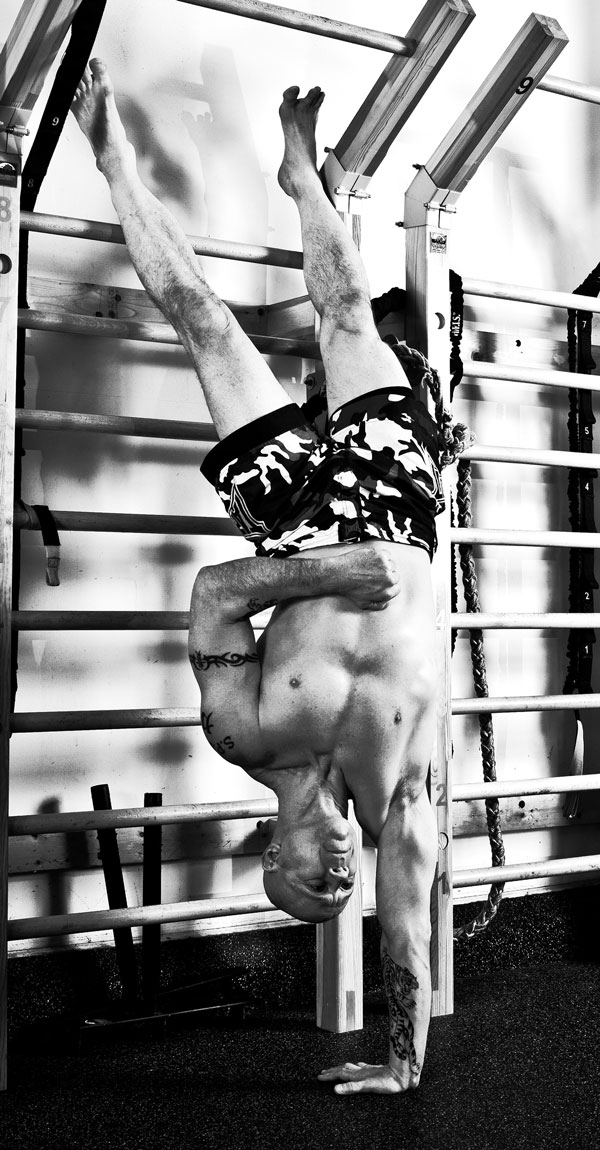
8)
Increased strength within athletic weight class. Two primary methods increase strength: muscle hypertrophy and neural adaptation. Standard resistance training increases strength by increasing the size of the muscle fibers. Due to the offset center of gravity and the shape of the kettlebell, the body must respond by recruiting motor units, stabilizers and the intrinsic muscles to keep the kettlebell in alignment. Hardstyle kettlebell training "teaches" the body how to be strong without adding great amounts of mass. Kettlebell training results include a harder, more flexible, explosive and lean body.
9)
Efficiency. Few people have a spare two or three hours a day to spend at the gym in the quest for ultimate fitness. When kettlebells and calisthenics are utilized, an hour is more than sufficient to accomplish the five essential modes of fitness: muscular strength, muscular endurance, cardiovascular fitness, flexibility and body composition (lean body mass).
There are also many 20 and 30-minute workouts including Tabatas, scrambled eggs and the warrior’s challenge (Ross & Gallagher, 2016). All of the facets of fitness, plus mobility, can be trained within a relatively short timeframe.
10)
Safe training for young athletes. Kettlebells are safe for
young athletes. Because of the offset center of gravity, a much
lighter kettlebell can help the athlete safely achieve the same results as training with a much heavier barbell. Calisthenics require no additional weight to employ.
Choosing Kettlebell and Bodyweight Training
Kettlebell and bodyweight training have existed for centuries. But, their popularity and acceptance in the United States has not been apparent until recently. I would attribute this fact to the time and practice required to learn how to use a kettlebell properly—and the fact that most calisthenics have been relegated to warm-ups. Likewise, kettlebell and bodyweight training doesn’t require "new and enhanced" equipment every year. So, equipment manufacturers can’t make incredible amounts of money through sales and leasing programs. Instead, gyms would need to invest in certification fees and educational resources for their staff. Only higher end facilities
invest in their trainers’ education at his level.
Is a strength and conditioning program featuring kettlebells and bodyweight exercise the
only answer to achieving ultimate strength and fitness? No, it is not. There are other bonafide training methods for developing strength and fitness. However, the kettlebell is the most universal tool. Combined with calisthenics, it provides a complete strength and conditioning system that addresses every aspect of fitness while requiring very little equipment.
A
kettlebell is the world’s only handheld gym.
Article References:
- Bryant, Cedric X., Ph.D., FASM and Green, Daniel J. Essentials of Exercise Science for Fitness Professionals. (2010, 2011, 2012) American Council on Exercise. ISBN 9781890720315. 4851 Paramount Drive, San Diego, CA, 92123
- Crawford, Nicole. 2012. Kids and kettlebells: is it safe? https://breakingmuscle.com/learn/kids-and-kettlebells-is-it-safe
- Fung B, Shore S. June 2010. Aerobic and Anaerobic Work During Kettlebell Exercise: A Pilot Study. Medicine and Science in Sports and Exercise, Volume 42:5 Supplement: S588-S589. http://physicaltherapyweb.com/kettlebell-therapy-restoring-movement-natural-physics/
- Green, Daniel J., Project Editor. ACE, American Council on Exercise. 2014. ISBN 978-1-890720-50-6. American Council on Exercise Personal Trainer Manual, Fifth Edition.
- Heid, Markum. February 29, 2012. Kettlebells vs freeweights: the smackdown. Men’s Health. http://www.menshealth.com/fitness/kettlebells-vs-free-weights-the-smackdown
- John, Dan. May 8th, 2017. 6 big questions about kettlebell training. https://www.dragondoor.com/6_big_questions_about_kettlebell_training_part_1/
- Holder, Steven. 2016. Colts trading bench presses for Turkish getups. http://www.indystar.com/story/sports/nfl/colts/2016/07/30/colts-trading-bench-presses-turkish-getups/87750490/
- Manocchia, Pat; Spierer, David K; Minichiello, Jackie; Braut, Steven; Castro, Jessica; Markowitz, Ross. January, 2010. Volume 24, Issue p1. http://journals.lww.com/nsca-jscr/Fulltext/2010/01001/Transference_Of_Kettlebell_Training_To_Traditional.100.aspx doi: 10.1097/01.JSC.0000367164.33477.62
- McElroy, Brandon. January 1, 2014. Vo2 max protocol. Onnit Academy. https://www.onnit.com/academy/vo2-max-protocol/
- Nguyen, Tuan. May, 2016. Who invented the kettlebell? https://www.thoughtco.com/who-invented-the-kettlebell-4038483
- Petrucci, Kellyann and Flynn, Patrick. 2015. Paleo Workouts for Dummies. Publisher:For Dummies; 1 edition
- Powers, Scott K., and Howley, Edward T. 2015. Exercise Physiology, Theory of Application and Performance. 9th ed. New York: McGraw-Hill.
- Read, Andrew. 2013. The right tool for the right job: kettlebell, dumbbell, or barbell? Breaking Muscle. https://breakingmuscle.com/learn/the-right-tool-for-the-right-job-kettlebell-dumbbell-or-barbell
- Ross, Phil and Gallagher, Marty. 2016. Ferocious Fitness, a Fighter’s Proven Action Plan. Little Canada, MN: Dragon Door Publications.
- Takano, Bob. August 6, 2015. How much time does it take to learn technique in the Olympic lifts? http://blog.trainheroic.com/learn-olympic-lifts/
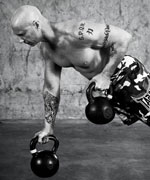 Phil Ross, Master RKC
Phil Ross, Master RKC created
The Kettlebell Workout Library and co-authored
Ferocious Fitness: A Fighter’s Proven Action Plan to Develop Blazing Power, Animalistic Strength and Killer Conditioning with Marty Gallagher. He has dedicated his life to training and developing programs to help athletes, fitness enthusiasts, personal trainers, coaches, law enforcement, military personnel, executives, surgeons and special needs clients to reach their goals, improve their performance and their lives.
Back